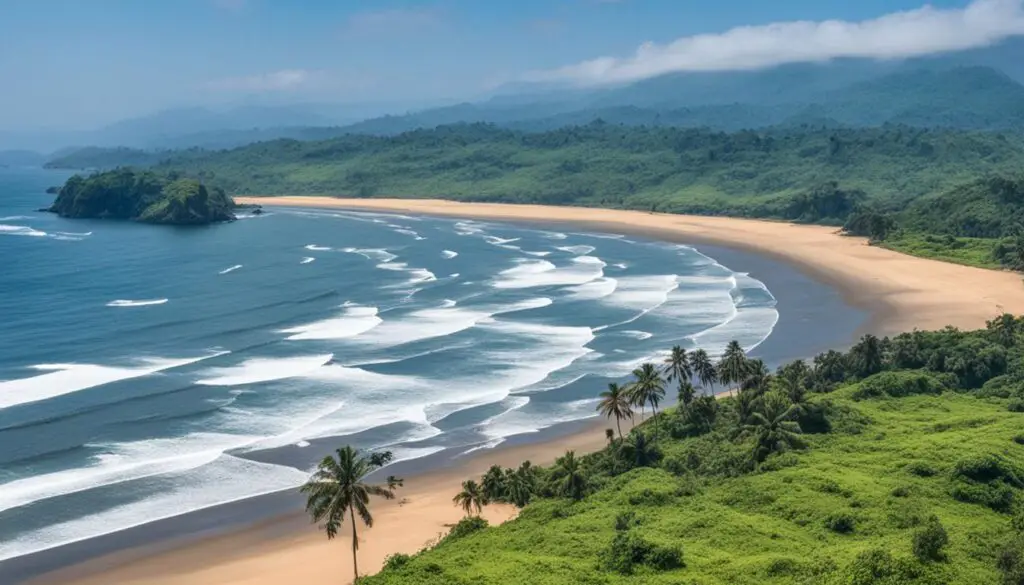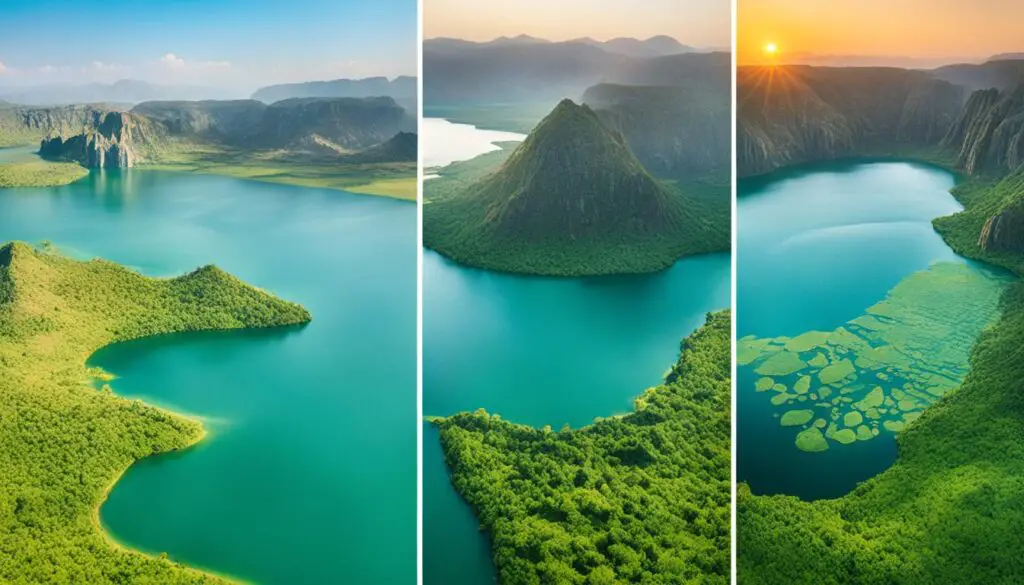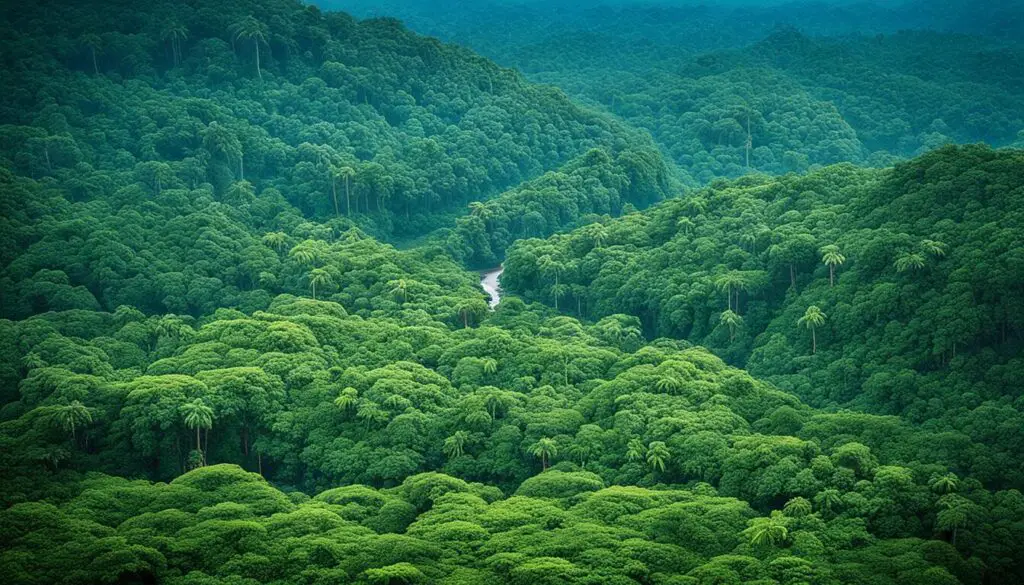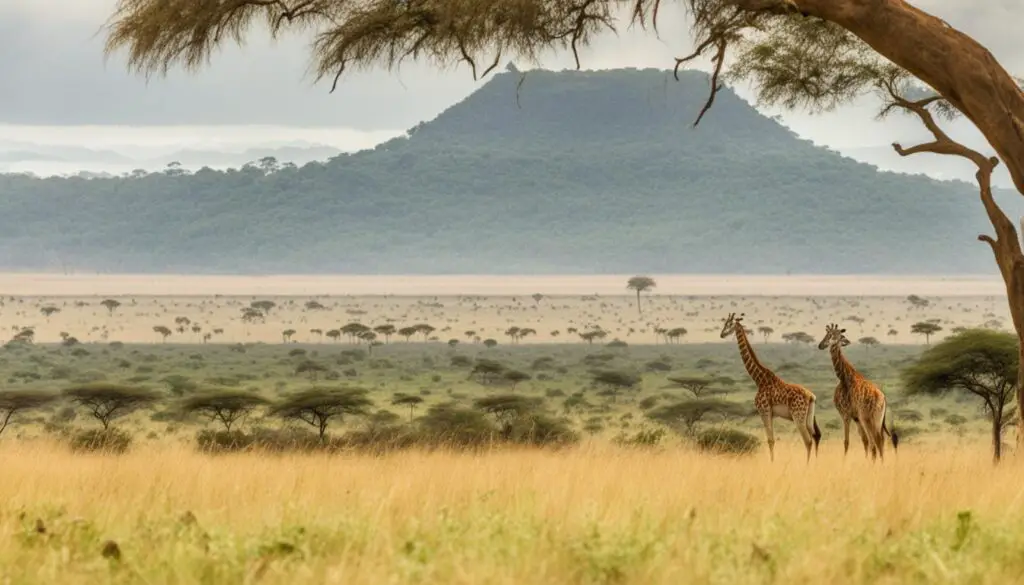Welcome to the awe-inspiring world of Cameroon, a country that boasts a geography as diverse as its cultural heritage. From magnificent volcanic peaks to lush rainforests nestled in the Congo Basin, Cameroon is a haven for nature enthusiasts and adventure seekers alike.
Cameroon’s geographical wonders are a testament to the marvels of our planet. As you embark on a journey through this captivating country, be prepared to be mesmerized by the raw beauty and untamed wilderness that awaits you.
Key Takeaways:
- Cameroon’s geography is diverse and encompasses volcanic peaks, rainforests, and the Congo Basin.
- The country’s natural wonders offer a wealth of opportunities for adventure and exploration.
- The volcanic peaks of Cameroon are a sight to behold, with Mt. Cameroon being a prominent highlight.
- The lush rainforests of the Congo Basin are home to rich biodiversity and unique wildlife species.
- Exploring Cameroon’s geography is an adventure that invites you to experience the beauty of nature and witness the incredible ecosystems that thrive within its boundaries.
Overview of Cameroon’s Geography
In this section, we will provide an overview of Cameroon’s geography, highlighting its diverse range of geographic features, extensive land area, and neighboring countries.
Cameroon, located in Central Africa, boasts a remarkable variety of natural landscapes. From towering mountains to winding rivers and vast lakes, this country is a treasure trove of geographic wonders.
With a land area of approximately 475,440 square kilometers, Cameroon is bordered by six countries: Nigeria to the west, Chad to the northeast, the Central African Republic to the east, Equatorial Guinea, Gabon, and the Republic of the Congo to the south.

One of the notable geographic features of Cameroon is its magnificent mountains. The country is home to the impressive Mount Cameroon, an active volcano and the highest peak in West Africa, reaching an elevation of 4,095 meters (13,435 feet) above sea level.
In addition to mountains, Cameroon is crisscrossed by several major rivers, including the Benue, Sanaga, and Logone rivers. These waterways not only enhance the natural beauty of the country but also play a vital role in supporting agriculture, transportation, and the overall economy.
Cameroon is also blessed with an array of stunning lakes, such as Lake Chad, which is shared with neighboring countries. These lakes provide valuable water resources, support diverse ecosystems, and contribute to the livelihoods of local communities.
The geographical diversity of Cameroon makes it a fascinating country to explore. Whether you’re an avid hiker seeking mountain adventures, a nature lover eager to witness the lushness of rainforests, or simply intrigued by unique landscapes, Cameroon has something to offer for everyone.
Mountains and Volcanoes of Cameroon
Cameroon’s geography is marked by its impressive mountains and active volcanic activity. Among these natural wonders, one stands out: the famous Mt. Cameroon. As the highest peak in the country, Mt. Cameroon reaches an elevation of 4,040 meters (13,255 feet).
Volcanic activity in Cameroon has shaped its landscapes and contributed to its unique geography. The country is part of the Central African Rift System, which gives rise to volcanic activity. Mt. Cameroon, an active stratovolcano, is an iconic symbol of this geological phenomenon.
With its dramatic slopes and breathtaking vistas, Mt. Cameroon attracts adventurers and nature enthusiasts from around the world. Climbing to its summit offers a challenging and rewarding experience, with panoramic views of the surrounding areas and the Atlantic Ocean.
Aside from Mt. Cameroon, there are other notable peaks in Cameroon. These include Mt. Oku, also known as Kilum Mountain, and Mt. Manengouba. These mountains contribute to the country’s diverse topography and provide opportunities for various outdoor activities and exploration.
As you venture through Cameroon, don’t miss the chance to witness the majestic beauty of Mt. Cameroon and explore the intriguing volcanic activity that has shaped this remarkable land.
Rivers and Lakes in Cameroon
Cameroon is blessed with a network of major rivers that flow through its stunning landscapes, nourishing the country with their abundant water resources. These rivers serve as lifelines, shaping the geography and supporting various ecosystems.
Major Rivers
The major rivers in Cameroon include the Sanaga, Wouri, and Logone rivers. The Sanaga River is the longest river in the country, flowing for approximately 918 kilometers (570 miles). It originates from the Adamawa Plateau and empties into the Atlantic Ocean. The Wouri River, on the other hand, flows through the economic capital, Douala, before reaching the Gulf of Guinea. Lastly, the Logone River forms a natural border between Cameroon and its neighbor, Chad, before joining the Chari River.
These rivers play a vital role in the lives of the local communities, providing water for drinking, irrigation, and transportation. They also support diverse ecosystems, acting as habitats for numerous fish species and other aquatic life.
Lake Chad and Lake Nyos
Cameroon is also home to several notable lakes, including the iconic Lake Chad and Lake Nyos. Lake Chad, one of the largest lakes in Africa, lies in the far north of Cameroon and extends into the territories of Chad, Niger, and Nigeria. It is a significant freshwater resource and is known for its rich biodiversity, supporting various fish species, plants, and birdlife.
On the other hand, Lake Nyos is a unique and captivating natural wonder. Located in the Northwest Region of Cameroon, this crater lake offers a picturesque sight with its serene blue waters. While its beauty attracts visitors, it is also known for a tragic incident that occurred in 1986 when a carbon dioxide eruption resulted in the release of the deadly gas, leading to the loss of human and animal lives.
Exploring the rivers and lakes in Cameroon provides a glimpse into the country’s natural treasures and the essential role they play in sustaining the environment and livelihoods of the people. Witness the majesty of these water bodies and immerse yourself in the wonders they hold.

The Coastal Region
Located along the borders of the Atlantic Ocean, Cameroon’s coastal region is a haven of natural beauty and leisure. With pristine beaches that stretch as far as the eye can see, this region offers a perfect destination for sun-seekers and beach enthusiasts.

From the moment you set foot on the warm sands, you’ll be captivated by the picturesque views and refreshing ocean breeze. Whether you’re looking to relax under the shade of palm trees or engage in exciting water sports, the coastal region has something for everyone.
If you’re planning a vacation, you’ll find a range of beach resorts that cater to different preferences and budgets. From luxurious accommodations with private beach access to cozy bungalows nestled amidst lush tropical gardens, there’s a resort to suit every taste.
One of the highlights of the coastal region is the fishing industry. With the Atlantic Ocean as its bountiful playground, Cameroon boasts a thriving fishing industry that plays a vital role in the local economy. The coastal communities rely on fishing for sustenance and livelihood, showcasing the deep connection between the people and the sea.
Whether you’re strolling along the shorelines, indulging in delicious seafood, or immersing yourself in the vibrant culture of coastal towns, the coastal region of Cameroon promises an unforgettable experience that combines natural wonders and rich cultural heritage.
Cameroon’s Rainforests
Cameroon is home to some of the most remarkable rainforests in the world, nestled within the expansive Congo Basin. These dense and lush forests are a testament to the country’s exceptional biodiversity and serve as a haven for unique wildlife species.
The Congo Basin, located in the central part of Africa, is one of the largest intact rainforest ecosystems on Earth, encompassing several countries including Cameroon. With its vast expanse of greenery, it plays a vital role in regulating the global climate and preserving the planet’s ecological balance.
Within Cameroon’s rainforests, a rich tapestry of life thrives. The biodiversity in these forests is unparalleled, housing an incredible array of plant and animal species. From towering trees to vibrant undergrowth, every corner of the rainforest teems with life.
One of the most iconic residents of Cameroon’s rainforests is the western lowland gorilla. These majestic creatures, with their imposing presence, are a symbol of the wildlife that thrives in this unique habitat. Other primate species, such as chimpanzees and mandrills, also call these forests their home.

The rainforests of Cameroon are also inhabited by a diverse range of bird species, including the African grey parrot, known for its remarkable intelligence and mimicry abilities. Colorful butterflies flutter through the foliage, while elusive forest elephants traverse the undergrowth.
These rainforests provide a sanctuary for countless plant species as well. The towering trees form a vibrant canopy, nurturing an array of orchids, ferns, and medicinal plants. The interdependent relationships between these plants, animals, and microorganisms create a delicate ecosystem that sustains life in remarkable ways.
Preserving the biodiversity and beauty of Cameroon’s rainforests is crucial for the well-being of our planet. Conservation efforts are vital to ensure the long-term survival of these ecosystems and the countless species that depend on them.
Exploring the rainforests of Cameroon is a captivating journey into a world brimming with life, where every step reveals new wonders. From the mighty Congo Basin emerges a symphony of biodiversity and wildlife that leaves a lasting impression on all who have the privilege of experiencing it.
Savannah and Grasslands of Cameroon
Cameroon is not only known for its dense rainforests and volcanic peaks, but also for its vast savannah and grasslands that stretch across the country. These unique landscapes offer a distinct ecosystem that supports a variety of flora and fauna.
The Savanna Ecosystem
The savannah ecosystem in Cameroon features wide-open grassy plains, scattered trees, and occasional patches of shrubs. This type of ecosystem is characterized by a dry season followed by a rainy season, creating a fluctuating environment that adapts to the changing weather patterns.

Grazing Animals
The grasslands of Cameroon are home to numerous grazing animals, such as zebras, antelopes, giraffes, and various species of gazelles. These herbivores rely on the abundant grasses for their food source, while predators like lions and cheetahs take advantage of the presence of these grazing animals.
Cultural Significance
The savannah and grasslands hold cultural significance for the people of Cameroon. These landscapes have been part of the traditional way of life for many communities, influencing their customs, folklore, and even their economic activities. The grasslands also serve as grazing grounds for livestock, providing a vital resource for pastoralist communities.
Next, we’ll explore the northern desert region of Cameroon, known as the Sahel, and the unique challenges it faces due to desertification.
Northern Desert Region
The northern region of Cameroon, known as the Sahel, is an expansive desert area that presents unique challenges and a fascinating way of life. This region, part of the Sahel region that spans across Africa, is characterized by its arid climate and the gradual expansion of desertification, posing significant environmental concerns.
The Threat of Desertification
The Sahel region in Cameroon faces the continuous threat of desertification, which refers to the process of fertile land turning into desert due to various factors such as climate change, deforestation, and unsustainable agricultural practices. The encroachment of the desert puts immense pressure on the local communities and their livelihoods. It affects their access to water, cultivable land, and biodiversity, exacerbating poverty and food insecurity in the region.
The Way of Life for Nomadic Tribes
Despite the challenges posed by the desertification process, the Sahel region is home to several nomadic tribes that have adapted their way of life to thrive in this harsh environment. These tribes, including the Fulani, Tuareg, and Tubu, have traditionally practiced pastoralism, moving with their herds of cattle, goats, and camels in search of water and grazing pastures.
This nomadic lifestyle has not only shaped their cultural identity but has also allowed them to sustain themselves and their communities through the centuries. The nomadic tribes have intricate knowledge of the land, its resources, and sustainable farming practices that have enabled them to thrive in the Sahel region.
Their cultural traditions, such as music, crafts, and storytelling, are deeply rooted in their nomadic heritage and contribute to the rich cultural tapestry of Cameroon. Despite the encroaching desert, these resilient nomadic tribes continue to preserve their traditions and pass them down to future generations.
Conclusion
In conclusion, Cameroon’s geography is a treasure trove of diverse landscapes and natural wonders. From the majestic volcanic peaks to the dense rainforests of the Congo Basin, the country offers a visual feast for nature enthusiasts and adventure seekers. Cameroon’s geographic features, including its mountains, rivers, lakes, coastal regions, and deserts, collectively contribute to its rich biodiversity and unique ecosystems.
Exploring Cameroon’s geography allows visitors to witness the astounding beauty of its volcanic peaks, such as the renowned Mt. Cameroon. The lush rainforests of the Congo Basin are home to a myriad of fascinating wildlife species and boast exceptional biodiversity. Cameroon’s coastal regions, with their pristine beaches and thriving fishing industry, offer a perfect retreat for relaxation and enjoyment.
Moreover, the savannahs and grasslands of Cameroon provide an opportunity to immerse oneself in the country’s cultural heritage and witness the majestic graze of wildlife that roams these landscapes. Additionally, the northern region’s Sahara-like Sahel region invites travelers to experience the unique way of life of nomadic tribes, while recognizing the challenges of desertification.
Cameroon’s geography encompasses a wide range of experiences and attractions. Whether one seeks adventure, beauty, or cultural exploration, this country has it all. Embark on an unforgettable journey through Cameroon’s diverse landscapes and discover the hidden gems that await within its borders.
FAQ
What is the geography of Cameroon like?
Cameroon has a diverse geography, with volcanic peaks and lush rainforests in the Congo Basin.
Can you provide an overview of Cameroon’s geography?
Certainly! Cameroon has various geographic features including mountains, rivers, and lakes. It also shares borders with neighboring countries.
What are the mountains and volcanoes in Cameroon?
One prominent mountain in Cameroon is Mount Cameroon, known for its volcanic activity. The country is also home to other high peaks.
Are there any notable rivers and lakes in Cameroon?
Yes, Cameroon is blessed with major rivers and lakes, including Lake Chad and Lake Nyos. These water bodies hold significance both geographically and culturally.
Tell me about the coastal region of Cameroon.
Cameroon’s coastal region stretches along the Atlantic Ocean. It boasts beautiful beaches, popular beach resorts, and a thriving fishing industry.
What can you tell me about the rainforests in Cameroon?
Cameroon is part of the vast Congo Basin rainforests. These rainforests are known for their exceptional biodiversity and are home to numerous wildlife species.
How would you describe the savannah and grasslands in Cameroon?
The savannah and grasslands in Cameroon form a unique ecosystem. They support grazing animals and hold cultural significance for the local population.
Is there a desert region in Cameroon?
Yes, the northern part of Cameroon is known as the Sahel region, which is characterized by desert landscapes. Desertification poses challenges, and the region is home to nomadic tribes.
What can we conclude about the geography of Cameroon?
In conclusion, Cameroon’s geography offers a wide range of landscapes, from volcanic peaks to rainforests, coastal regions, and desert areas. It contributes to the country’s biodiversity, cultural heritage, and economic activities.